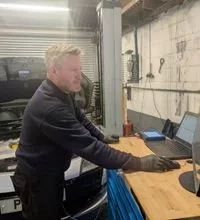Q&A: Prof. David Keene

Professor David Keene, Automotive Council UK board member and CEO of Coventry-based Aurrigo International, explains how he grew a successful autonomous technology business from traditional automotive roots.
How did Aurrigo get into automated mobility?
I started what was, and still is, an automotive company back in 1993. So, 31 years of designing and developing products for some of the best-known premium vehicle brands, the likes of Aston Martin, Bentley, Jaguar Land Rover and McLaren.
My background is technical, in electronic systems and software development. In 2014, I thought, let's do something interesting to demonstrate our capability, so I got our team to convert a vehicle so that it operated with just a steering wheel, pedals and an iPad.
Around that time, we became a founding member of the Niche Vehicle Network, a group of small UK car companies and suppliers including the likes of Ariel and Morgan. That caught the attention of Innovate UK, and, through them, the government commissioned us to work on the Lutz project, developing a drive-by-wire platform for a two-seater autonomous vehicle.
How did you come to specialise in aviation?
After Lutz, we built a four-seater called the Auto-Pod, and then the larger Auto-Shuttle. Then, one day, something amazing happened; we got a call from a guy at International Airlines Group, who said: ‘We've seen what you're doing with passenger vehicles, but could your technology move baggage or cargo containers?’
Of course, we said ‘Yes’, so we entered into a contract with IAG and Heathrow Terminal 5 for British Airways. We were especially proud to win the Heathrow technology of the year award, and new opportunities opened-up from there.
In late 2019, we met the innovation team for Changi Airport in Singapore, and within 30 minutes we’d agreed to work together. We signed an agreement in February 2020 and then, in March, the world changed with the pandemic.
While everyone else battened down the hatches, Changi did the opposite. They said, ‘Let's carry on with these technology projects and see if we can get ahead’. So, we worked remotely developing our Auto-Sim 3D digital twin software. It enables us to model how the airport operates today, and how it might operate in the future.
What were the technical challenges of specialising in aviation?
The first great thing about working in an airport is that it's a very controlled environment. The second thing is the low speeds. We’ve been very fortunate to have stumbled across this niche because, in terms of commercialisation, that’s the key things you want.
From a technical perspective, airside operations are difficult, but easier than public roads. You’re much less likely to encounter all the edge cases you must solve and solve quickly because you're travelling at 70mph!
At Changi, we’re at the point where our all-electric autonomous Auto-DollyTug can go into a baggage hall, line-up and stretch out its robotic arms, collect a container and pull it onto the vehicle bed, drive along a roadway to a stand where an aircraft is waiting, enter that stand, work out where the loader bay is, dock with it, and push the container through the cargo door, all completely automatically.
We’ve proved that our vehicle can do its job repeatedly and reliably. It not only goes forward and backwards, but sideways. It can twist through 360 degrees. It can lift and lower to any of the deck heights in the airport. And we do all this in very high temperatures and in very heavy rainfall.
Where do you see Aurrigo in five years?
This year we’ve added five more airports to the list, with vehicles in the US, UK, Germany and Holland. The next phase of Changi is to increase the number of vehicles, to work as a fleet under our cyber-resilient Auto-Connect platform.
“In five years we want to be in every one of the 600 or so major international airports, moving baggage and cargo around autonomously, interfacing seamlessly with the aircraft and all the other manual processes and staff.




